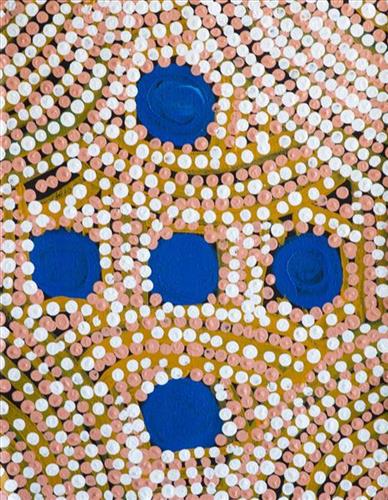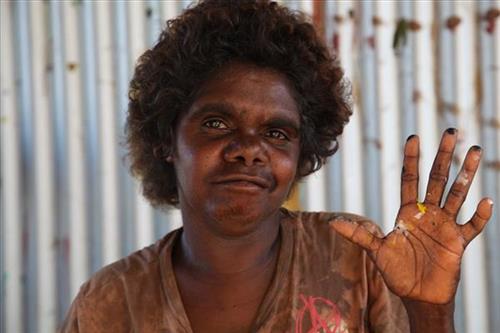111582085861
Untitled
“Christine paints the Country of her family, kakarra (east) way from Punmu [Aboriginal community]. There’s a big warla (lake) over three tuwa (sandhills).”
We’ve been in Punmu a long time. We moved from Camp 61, [an outstation on Bilanooka Station] where we were schooling the kids there. We moved to Punmu, and we stayed there. Big mob of us came back in a truck, in an old tractor with the trailer. That old truck still there at the turnoff. We came in that one now.”
– Debra Thomas, Christine Thomas’ mother
As a mute artist, painting is an important means of communication for Christine. She is part of the youngest generation of Martumili Artists, and like her contemporaries, Christine began to paint with her parents, grandparents and extended family. Today she most often paints alongside her partner and fellow Martumili Artist, Jason Tinker. This organic process of learning, not only about painting techniques, but also specific locations, family histories, traditional ways of life, and Jukurrpa (Dreaming) is an important way in which Martu culture is transferred intergenerationally and thus kept strong.
Christine’s subject matter is strongly informed by her traditional ngurra (home Country, camp), encompassing the area between Punmu and Kunawarritji through her father and around the Karlamilyi (Rudall River) region through her mother.
Stylistically Christine’s paintings meld traditional and contemporary elements, demonstrating the development of her own aesthetic while continuing to reflect the powerful influence of her elders. Dotted paint applied in modern palettes depict walka (designs), iconographic forms universally shared across the Western Desert. For many thousands of years these designs have represented men and women, kapi (water sources), tali (sandhills), different varieties of warta (trees, vegetation), ngarrini (camps), jina (tracks), jila (snakes), and Jukurrpa (Dreaming) ancestral beings.




